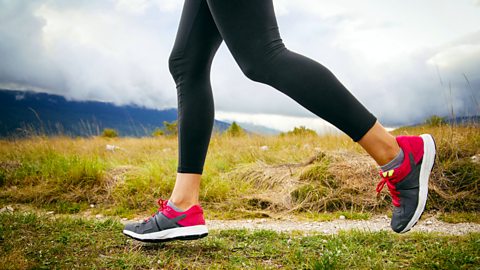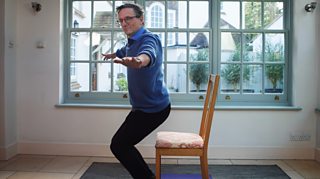Six things you should know before buying your next running shoes
Sliced Bread is testing more wonder products suggested by you to see if their claims stand up to scrutiny.
Listeners Mike and Beth are two of the 5 million people who've downloaded the NHS and �鶹��'s Couch to 5K app. In an exercise-themed episode, they asked Greg Foot to find out whether it's worth upgrading their running shoes.
The prices of the most expensive ones can make you scream but do they make you go faster? Does paying more reduce your chance of an injury while pounding the pavement?
Greg quickly discovers that answering these questions is more of a hurdle than a sprint. Guiding him to the finish line are biomechanist Dr Hannah Rice, sports technologist Professor Mike Caine and runner, journalist and world record holder (for the fastest marathon in a full body animal costume – female) Kate Carter.
So which of their findings are most relevant to runners tempted by a flash new pair of trainers?
1. How we run is different to the way we walk
"We have a running gait that is completely individual to us," explains Kate Carter, "it's like our kind of running fingerprint." The factors determining this fingerprint include how our feet land and how our body moves, for example when our feet hit the ground they may move inward or outward slightly or, adds Kate, "make your knees knock together or come out apart".

2. What to look for when shopping for running shoes
Kate suggests that a good running shop would either have a treadmill in-store to analyse a customer's running gait or ask them to run up and down the road outside the shop. "They look at the way you run, and they'll say to you, 'right, you run in this way, you probably need these kind of trainers.'"
You might be lucky that you don't need much support and you can get away with a £40 pair of shoes.
This assessment will determine whether you need more support in your shoes. "There’s a range there," says Kate, "and so you might be lucky that you don't need much support and you can get away with a £40 pair of shoes, or you might need support and those shoes just might end up costing more."
3. But your body can still go its own way
When it comes to comfort, cushioning may well make the wearer feel good. However, whether it can help prevent injury is another matter.
A professor of biomechanics from the Norwegian School of Sports Science, Dr Hannah Rice looks at how people walk and run with a view to understanding injury risk. She tells Greg that the preoccupation with cushioning and measures to prevent pronation (how much your foot moves inwards when you run) could be misleading.
She also explains that recent research under the banner of the 'preferred movement path paradigm' suggests that "whatever shoe you put a person in, the skeleton will follow a particular path during running and you're not really able to change it with footwear or with insoles".
4. Improved performance doesn't mean improved fitness
Paying more to prevent injury may be a grey area, but performance is another matter. Sports technologist Professor Mike Caine explains that in the shoes worn by the likes of Kenyan long-distance runner Eliud Kipchoge, the heel strike – the point at which the runner first hits the ground – is losing the wearer less energy.
By contrast, wearing a more typical, spongy shoe means you would lose more energy when decelerating. As Mike explains, "in terms of running quickly, that’s not very efficient".
The Alphafly shoes have a carbon fibre plate or stiffening plate that changes the dynamic at the next stage of the running motion – rolling the foot forward and over the big toe joint and pushing off from the toes. These plates maximise the amount of energy that’s pushing the foot forward. The combination of this propulsion and the saved energy are "significant enough to add a small benefit to athletes that are looking to run faster, particularly at high speeds".
However, this improved performance means a reduced level of effort, a lower energy demand resulting in a less effective workout. That's important if you’re going for a 30-minute run on your lunch break to stay in shape.
5. Shoe comparisons aren't an exact science
The improved performance associated with the more expensive carbon fibre plate shoes has been borne out by studies, including one by The New York Times that, across a sample of 500,000 runners, recorded an average six-minute improvement for a three-hour marathon runners and an eight-minute improvement for a four-hour finish.
However, Mike says that, for more casual runners, while there are differences between different price points of running shoes "it's almost impossible to say with confidence on a single test, on a single subject, that that difference will be big enough to detect an attribute to the shoe because the variability in other factors is significant."
These factors include sleep, nutrition, training, how you feel on the day in terms of mood and even the weather!
"You need to run lots of tests on lots of athletes before you can be confident that you're isolating the effect of the shoe from the other variables," Mike concludes.

Will buying expensive running shoes make you run faster?
Sports technologist Professor Mike Caine says the answer is a bit more complicated.
6. From recreational runner to racer, there's a lot to consider…
The decisions can seem bewildering. There are competing concerns such as comfort, performance fitness and style. Plus there are hundreds of pairs on the market with prices ranging from £20 to £280. Can it be simply it a case of getting what you pay for?
"For your average recreational runner who isn't bothered about running as fast as they possibly can, I don't think it's worth spending more to get up to the carbon fibre plate type technologies," advises Mike. "But is that innovation genuine? Yes, it is. Athletes were complaining that it just simply wasn't fair, that they weren't competing on an even playing field. And that tells you all you need to know."
Kate Carter concurs but offers a caveat. "If you’re going to get them, save them for race day. Don't train in them every day because that really is a waste of money. It's like having a £5,000 bike and only using it to go to the corner shop."
Even if you pull out all the stops on the big day, Dr Hannah Rice cautions that you could be heading for a hollow victory: "If you've got a longstanding personal best that you've been trying to break for years and you just go and change your shoes, you might feel like a bit of a fraud."
So what will our listeners – recreational runner Mike and marathon racer Beth – do? Mike wondered about upgrading from £40 trainers to a mid-range pair around £100, while Beth was considering a move up from a £120 pair to more than double that price. Find out where they ended up by listening here.
The information contained in this article was correct at the time of broadcast on 5 May, 2022.
-
![]()
Listen to Sneakernomics
The stories behind the mavericks, hustlers and dreamers who've made – and been made by – trainers.

More articles from Radio 4
-
![]()
How did e-cigarettes and vaping get so popular?
The past, present and future of vapes and e-cigarettes
-
![]()
Electric cars: Eight things you need to know
Will swapping your petrol car for a new electric vehicle make you greener?
-
![]()
What are the benefits of 'eccentric excercise'?
The secret workout that's been hiding in your routine all along.
-
![]()
Do our skincare products stand up to scrutiny?
Greg Foot tests if the claims made on the packaging are more than just marketing hype.






